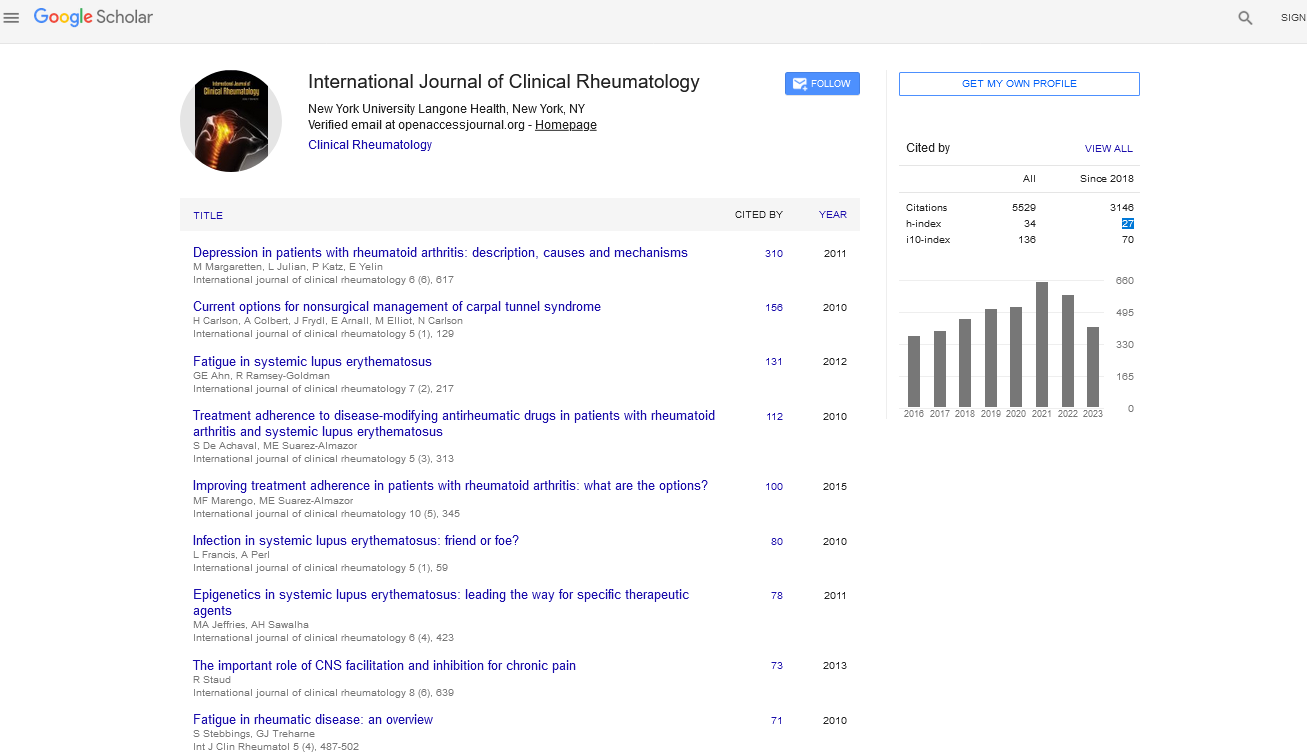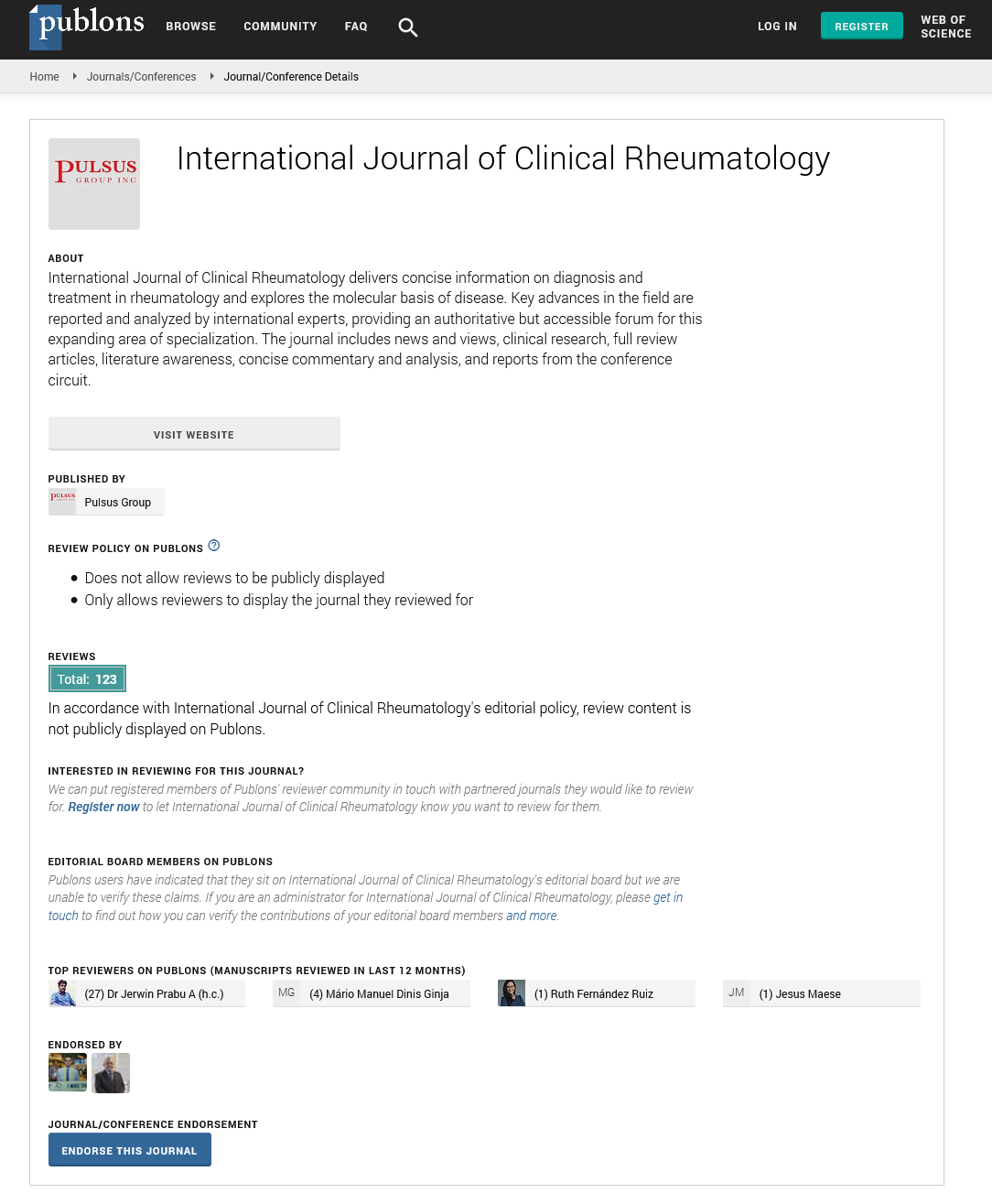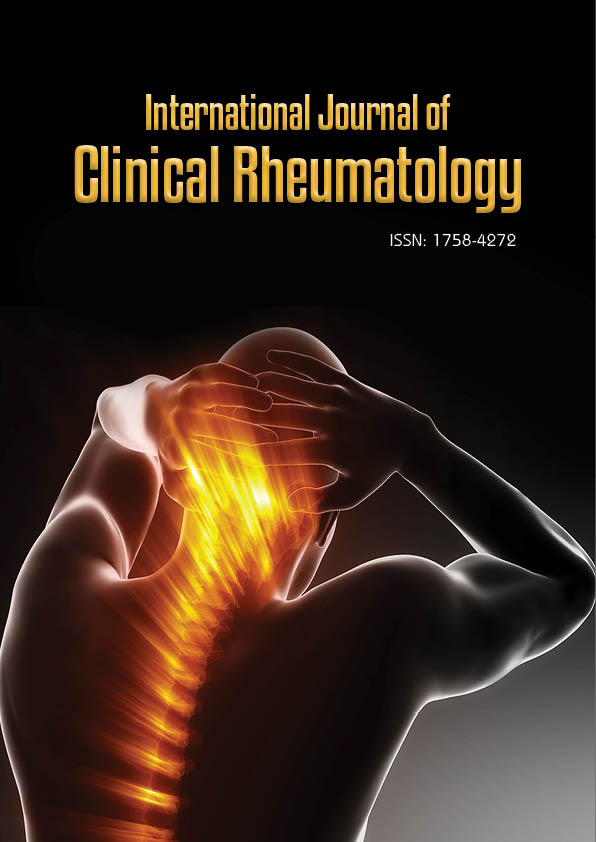Editorial - International Journal of Clinical Rheumatology (2025) Volume 20, Issue 1
The Impact of Gut Microbiota on Rheumatoid Arthritis: Exploring the Gut-Joint Axis
Sophia Green*
Division of Rheumatology, University of São Paulo, São Paulo, Brazil
- *Corresponding Author:
- Sophia Green
Division of Rheumatology, University of São Paulo, São Paulo, Brazil
E-mail: sophia.green56@yahoo.com
Received: 02-Jan-2025, Manuscript No. fmijcr-25-162974; Editor assigned: 04- Jan-2025, Pre-QC No. fmijcr-25-162974 (PQ); Reviewed: 18-Jan-2025, QC No. fmijcr-25-162974; Revised: 23-Jan-2025, Manuscript No. fmijcr-25-162974 (R); Published: 30-Jan-2025, DOI: 10.37532/1758- 4272.2025.20(1).398-401
Abstract
Rheumatoid arthritis (RA) is a chronic autoimmune disease characterized by inflammation and joint damage. While genetic and environmental factors have long been recognized as contributors to RA pathogenesis, recent studies have highlighted the potential role of the gut microbiota in influencing disease development and progression. The gut microbiota, consisting of trillions of microorganisms, plays a key role in maintaining immune homeostasis and modulating systemic inflammation. Dysbiosis, or an imbalance in the composition of the microbiota, has been implicated in various autoimmune diseases, including RA. This article reviews current evidence on the gut-joint axis, exploring the mechanisms through which gut microbiota may influence RA pathogenesis. We discuss the role of microbial metabolites, immune system modulation, and microbial-induced inflammation in RA. Additionally, potential therapeutic approaches aimed at restoring a healthy gut microbiome, such as probiotics, prebiotics, and fecal microbiota transplantation (FMT), are explored. Although promising, further research is needed to establish causal relationships and determine the therapeutic potential of microbiome-targeted therapies in RA.
Keywords
Rheumatoid arthritis• Gut microbiota• Dysbiosis• Gut-joint axis• Immune modulation• Probiotics• Prebiotics• Fecal microbiota transplantation• Inflammation• Microbiome therapy
Introduction
Rheumatoid arthritis (RA) is a systemic autoimmune disease that primarily affects the joints, leading to inflammation, pain, and eventually joint destruction. The exact cause of RA remains unclear, but it is believed to result from a combination of genetic predisposition and environmental triggers, such as infections, smoking, and diet. In recent years, a growing body of evidence has pointed to the gut microbiota as a significant factor in the development and progression of RA. The gut microbiota, composed of a diverse range of bacteria, fungi, viruses, and archaea, plays a central role in regulating the immune system and maintaining gut integrity. Dysbiosis, or an imbalance in the composition of the microbiota, has been associated with a range of autoimmune conditions, including RA. The concept of the "gut-joint axis" refers to the idea that changes in the gut microbiota can influence systemic inflammation, thereby impacting the joints and contributing to the pathogenesis of RA. This hypothesis is supported by numerous studies showing that RA patients exhibit distinct gut microbiota profiles compared to healthy individuals. Additionally, emerging research has highlighted the potential for microbiome-targeted therapies, such as probiotics, prebiotics, and fecal microbiota transplantation (FMT), to modulate disease activity in RA. This article reviews the current understanding of the relationship between gut microbiota and RA, with a focus on the mechanisms underlying the gut-joint axis and the potential therapeutic strategies that aim to restore a healthy microbiome [1-6].
Gut microbiota composition in RA patients
Several studies have investigated the gut microbiota composition in RA patients, with most reporting an altered microbiome compared to healthy controls. Notably, RA patients often exhibit a decrease in microbial diversity, which is a hallmark of dysbiosis. Specific bacterial species have been found to be either overrepresented or underrepresented in RA patients, contributing to inflammation and immune dysregulation.
Prevotella and bacteroides: One of the most consistent findings in RA microbiome studies is the overrepresentation of Prevotella species and the underrepresentation of Bacteroides. These bacteria are involved in different aspects of immune system regulation, and imbalances in their relative abundance may promote pro-inflammatory responses. Prevotella has been implicated in the production of short-chain fatty acids (SCFAs), which can influence immune cell function and the inflammatory response [7].
Firmicutes and actinobacteria: In addition to Prevotella, an increased abundance of Firmicutes and a reduction in Actinobacteria have been observed in RA patients. Firmicutes are involved in the fermentation of dietary fiber and the production of SCFAs, which help maintain gut barrier integrity and modulate immune function. Dysbiosis in RA may lead to impaired SCFA production, contributing to intestinal inflammation and systemic immune activation [8].
Methanobrevibacter: The presence of Methanobrevibacter species, archaea that produce methane, has also been linked to RA. Increased levels of methane in the gut may exacerbate gut permeability, which in turn allows the translocation of microbial antigens into the bloodstream, potentially triggering systemic inflammation and joint damage.
Gut-Joint axis and immune modulation
The gut microbiota influences RA pathogenesis through its interactions with the immune system. The gut is home to a large portion of the body’s immune cells, and the gut microbiota plays a critical role in shaping immune responses. Dysbiosis can lead to the activation of inflammatory pathways, which may extend beyond the gut and affect distant tissues, including the joints.
Th17 Cells and IL-17: One of the key immune pathways implicated in RA is the Th17 cell-mediated response. Th17 cells produce interleukin-17 (IL-17), a pro-inflammatory cytokine that promotes the recruitment of neutrophils and macrophages to inflamed tissues. Studies have shown that an altered gut microbiome can increase the production of IL-17, leading to systemic inflammation and the development of autoimmune responses that target the joints.
T regulatory cells (Tregs): Tregs play a critical role in maintaining immune tolerance and preventing autoimmunity. Dysbiosis has been associated with impaired Treg function, leading to a loss of immune tolerance and the development of autoimmune diseases such as RA. Certain bacterial species in the gut may influence Treg differentiation, and an imbalance in these bacteria may reduce the body’s ability to regulate immune responses [9].
Molecular mimicry: Another potential mechanism by which gut microbiota may influence RA is through molecular mimicry. Some gut bacteria share structural similarities with human proteins, and their antigens may trigger an immune response that cross-reacts with self-tissues, leading to autoimmune joint damage. This mechanism has been proposed to explain the association between certain bacterial species and the development of RA.
Therapeutic Approaches Targeting the Gut Microbiome
The idea of modifying the gut microbiome to treat RA is an exciting and emerging area of research. Several therapeutic strategies are currently being explored, including probiotics, prebiotics, and fecal microbiota transplantation (FMT).
Probiotics: Probiotics, which are live microorganisms that confer health benefits when consumed, have been investigated for their potential to modulate the gut microbiome and reduce inflammation in RA. Some studies have reported beneficial effects of probiotics on disease activity, pain, and inflammation, although the results are not universally consistent. Probiotics may work by restoring microbial diversity, enhancing gut barrier function, and modulating immune responses.
Prebiotics: Prebiotics are dietary fibers that promote the growth of beneficial gut bacteria. In animal models of RA, prebiotics have been shown to reduce inflammation and protect against joint damage. Clinical studies on prebiotics in RA are limited, but early findings suggest they may offer a complementary approach to managing disease activity by improving gut health and immune modulation.
Fecal microbiota transplantation (FMT): FMT, which involves transferring the gut microbiota from a healthy donor to a recipient, has gained attention as a potential treatment for various autoimmune diseases. FMT has shown promise in modulating the gut microbiome and reducing inflammation in conditions like inflammatory bowel disease (IBD). Ongoing studies are investigating the effects of FMT in RA, with some early trials showing improvements in disease activity and joint function.
Discussion
The concept of the gut-joint axis offers a new perspective on the pathogenesis of RA, emphasizing the role of gut microbiota in influencing immune system function and inflammation. While the exact mechanisms remain unclear, growing evidence suggests that dysbiosis may play a central role in triggering and sustaining autoimmune responses in RA. By modulating the gut microbiota, it may be possible to reduce inflammation, restore immune tolerance, and potentially alter the course of RA [10].
Although microbiome-targeted therapies such as probiotics, prebiotics, and FMT show promise, their clinical application in RA is still in its early stages. Large-scale, well-controlled clinical trials are needed to confirm their efficacy and safety. Furthermore, it remains to be seen whether microbiome-based therapies will be used as adjuncts to conventional RA treatments or as standalone therapies.
Conclusion
The gut microbiota plays a crucial role in the development and progression of rheumatoid arthritis through its influence on immune modulation and systemic inflammation. Dysbiosis in RA patients is associated with altered microbial profiles and immune system dysfunction, which may contribute to joint inflammation and damage. Emerging therapeutic strategies, such as probiotics, prebiotics, and fecal microbiota transplantation, offer promising potential for modulating the microbiome and improving RA outcomes. However, further research is needed to fully understand the mechanisms involved and to establish the clinical efficacy of microbiome-based therapies. As our understanding of the gut-joint axis deepens, microbiome-targeted therapies may become an integral part of RA management in the future.
References
- Yehuda Z, Alper A, Scott D, et al. Aneurysmal bone cyst of mandibular condyle: A case report and review of the literature. J Craniomaxillofac Surg. 40(8), 243-248 (2012).
- Mankin HJ, Hornicek FJ, Ortiz-Cruz E, et al. Aneurysmal bone cyst: a review of 150 patients. J Clin Oncol. 23(27), 6756-6762 (2005).
- Baig R, Eady J. Unicameral (simple) bone cysts. Southern Med J. 99(9), 966-976 (2006).
- Rapp TB, Ward JP, Alaia MJ. Aneurysmal Bone Cyst. J Am Acad Orthop Surg. 20(4), 233-241 (2012).
- Rodrigues CD, Carlos E. Traumatic Bone Cyst Suggestive of Large Apical Periodontitis. J Endod. 34(4), 484-489 (2008).
- Kayani B, Sharma A, Sewell MD, et al. A Review of the Surgical Management of Extrathoracic Solitary Fibrous Tumors. Am J Clin Oncol. 41(7), 687-694 (2018).
- Choi H, Charnsangavej C, Faria SC. Correlation of computed tomography and positron emission tomography in patients with metastatic gastrointestinal stromal tumor treated at a single institution with imatinib mesylate: proposal of new computed tomography response criteria. J Clin Oncol. 25(13), 1753-1759 (2007).
- Taniguchi S, Ryu J, Seki M. Long-term oral administration of glucosamine or chondroitin sulfate reduces destruction of cartilage and up-regulation of MMP-3 mRNA in a model of spontaneous osteoarthritis in Hartley guinea pigs. J Orthop Res. 30(5), 673-678 (2012).
- Reginster J-Y, Bruyere O, Neuprez A. Current role of glucosamine in the treatment of osteoarthritis. Rheumatology. 46(5), 731-735 (2007).
- Scholtissen S, Bruyère O, Neuprez A, et al. Glucosamine sulphate in the treatment of knee osteoarthritis: cost-effectiveness comparison with paracetamol. Int J Clin Pract. 64(6), 756-762 (2010).
Indexed at, Google Scholar, Crossref
Indexed at, Google Scholar, Crossref
Indexed at, Google Scholar, Crossref
Indexed at, Google Scholar, Crossref
Indexed at, Google Scholar, Crossref
Indexed at, Google Scholar, Crossref
Indexed at, Google Scholar, Crossref


